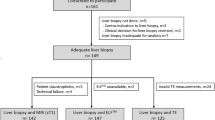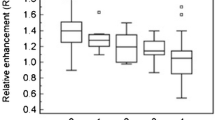Abstract.
The purpose of our study was to evaluate the ability of superparamagnetic iron oxide (SPIO)-enhanced MR imaging to detect liver fibrosis in patients with chronic liver disease and to compare the findings with histopathological data. Sixty-seven patients with chronic hepatitis (n=58) or focal nodular hyperplasia (FNH; n=9) were studied using a 1.5-T MR system. The protocol included proton density-weighted, T2-weighted spin-echo (SE) and fast SE (FSE) sequences before and after SPIO administration and T2*-weighted gradient-recalled-echo (GRE) sequences after SPIO. Pre- and post-contrast T2-weighted and T2*-weighted sequences were retrospectively evaluated by three independent observers for evidence of non-tumor hypersignal intensities. Three liver patterns were considered: thick reticulations; thin reticulations; and/or multiple areas of hypersignal intensities. Unenhanced or enhanced patterns were compared with histopathological specimens, which had been obtained by percutaneous biopsy of the right lobe within a maximum of 12 months of MR examination. Liver fibrosis was histologically graded using a five-level scale (F0–F4), according to the METAVIR classification. Histopathology demonstrated significant fibrosis (F2–F4) in 57 patients, non-significant fibrosis in 1 patient (F1), and normal liver surrounding FNH in 9 patients (F0). After SPIO administration, at least one pattern of non-tumor hypersignal intensities was seen in 43 (76%) of the 57 patients with F≥2 with good agreement (kappa=0.68) compared with 2 (20%) of the 10 F0/1 patients (p<0.01). Attenuated non-homogeneous liver-signal intensities with persistent thick reticulations, thin reticulations, or multiple areas of hypersignals were observed in, respectively, 30, 52, and 56% of patients with F≥2 with moderate agreement (kappa=0.51). Before SPIO, MR images were positive in 21 of 57 (37%) F≥2 and zero F0/1 patients. Post-contrast proton-density-weighted and T2*-weighted GRE were the most sensitive sequences for detecting non-tumor hypersignal intensities. In patients with chronic liver diseases, SPIO-enhanced MR imaging exhibits non-tumor hypersignal intensities indicative of liver fibrosis by decreasing the signal from the non-fibrotic areas where Kupffer cells are present.
Similar content being viewed by others
Author information
Authors and Affiliations
Additional information
Electronic Publication
Rights and permissions
About this article
Cite this article
Lucidarme, O., Baleston, F., Cadi, M. et al. Non-invasive detection of liver fibrosis: Is superparamagnetic iron oxide particle-enhanced MR imaging a contributive technique?. Eur Radiol 13, 467–474 (2003). https://doi.org/10.1007/s00330-002-1667-9
Received:
Revised:
Accepted:
Issue Date:
DOI: https://doi.org/10.1007/s00330-002-1667-9




